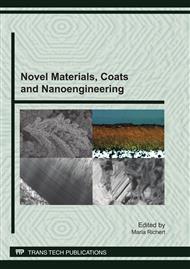p.61
p.71
p.81
p.89
p.97
p.105
p.113
p.121
p.129
Influence of Grain Refining on Abrasive Wear of Submicrocrystalline Al-Si Alloys
Abstract:
Light weight nano/submicrocrystalline materials are promising group of constructional materials combining low density with high mechanical properties. However, their potential application requires extensive testing of functional properties, e.g. tribological ones, which may be significant and determine their practical use. Available information on abrasive wear and friction coefficients in nano/submicrocrystalline materials is rather poor. Therefore the aim of this paper is to fill the gap in the literature in this field. The AlSi12Fe5Cu3Mg alloy (RS422) produced by rapid solidification and plastic consolidation with grain size of basic phase components in the range from 50 nm to 300 nm was examined. Microstructure and mechanical properties of the materials were determined. Abrasive wear tests, static and kinematics friction coefficients measurement were carried out under the surface condition including dry, wet and oil lubricant. The results have been compared to the values of similar quantities determined in the same conditions for conventionally produced alloy AlSi11FeCuMn (AK11). Substantial increase of friction coefficients for RS442 comparing to AlSi11FeCuMn material was found, however, abrasive wear for nano/submicron grained materials were low in comparison to conventional one. Considerable increase of abrasive wear at water presence and very weak attrition at oil lubrication was observed. Relationship between structure and mechanical properties of tested materials was analyzed.
Info:
Periodical:
Pages:
97-103
Citation:
Online since:
February 2011
Authors:
Price:
Сopyright:
© 2011 Trans Tech Publications Ltd. All Rights Reserved
Share:
Citation:


